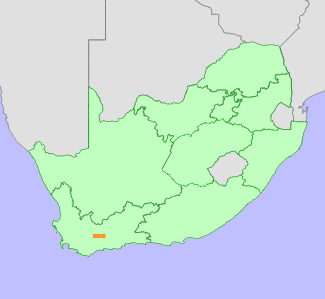|
Scientific Name | Gibbaeum nebrownii Tischer |
Higher Classification | Dicotyledons |
Family | AIZOACEAE |
Synonyms | Gibbaeum johnstonii Van Jaarsv. & S.A.Hammer, Imitaria muirii N.E.Br. |
National Status |
Status and Criteria | Endangered B1ab(iii,v)+2ab(iii,v); C1 |
Assessment Date | 2022/09/16 |
Assessor(s) | J.H. Vlok, A.L. Schutte-Vlok, A. Lynch, K. Lynch, D. Raimondo & N.N. Mhlongo |
Justification | This species has a limited distribution with an extent of occurrence (EOO) of 143 km² and an area of occupancy (AOO) of 20 km². It is known from four locations with an estimated population size of fewer than 2500 plants. The population is declining as a result of illegal collecting and trampling by livestock, and thus this species is listed as Endangered under criteria B and C. |
Distribution |
Endemism | South African endemic |
Provincial distribution | Western Cape |
Range | This species is endemic to the Western Cape Province, where it occurs south of Ladismith in the Little Karoo. |
Habitat and Ecology |
Major system | Terrestrial |
Major habitats | Western Little Karoo |
Description | It is found in shale slopes and flats. |
Threats |
| Illegal collection is a severe, ongoing threat to this species and there have been major reductions in the number of individuals due to collecting over the past 20 years. Succulent collectors have been reported to jump fences at one of the locations in a quest to locate and collect this species. One of the locations will soon be incorporated into a nearby wildlife reserve, which should hopefully reduce collecting pressure. This species was previously threatened by trampling by Springbok in one of the nature reserves, where there were too many springbok. Under new management, this reserve has removed ostriches and gemsbok to mitigate trampling of plant species in the reserve, while the Springbok population has died off. A historical subpopulation along a roadside near Ladismith was lost to road construction. |
Population |
The population size is estimated to be less than 2500 individuals from four subpopulations. This species is suspected to be declining due to illegal collection and trampling. It is projected that the population will experience a reduction of at least 20% in the next two generations (60 years) due to the combined effects of climate change, trampling and illegal collection.
|
Population trend | Decreasing |
Assessment History |
Taxon assessed |
Status and Criteria |
Citation/Red List version | | Gibbaeum nebrownii Tischer | CR B1ab(iii,v) | Raimondo et al. (2009) | | Gibbaeum nebrownii Tischer | Insufficiently Known | Hilton-Taylor (1996) | | Imitaria muirii N.E.Br. | Uncertain | Hall et al. (1980) | |
Bibliography |
Goldblatt, P. and Manning, J.C. 2000. Cape Plants: A conspectus of the Cape Flora of South Africa. Strelitzia 9. National Botanical Institute, Cape Town.
Hall, A.V., De Winter, M., De Winter, B. and Van Oosterhout, S.A.M. 1980. Threatened plants of southern Africa. South African National Scienctific Programmes Report 45. CSIR, Pretoria.
Hilton-Taylor, C. 1996. Red data list of southern African plants. Strelitzia 4. South African National Botanical Institute, Pretoria.
Raimondo, D., von Staden, L., Foden, W., Victor, J.E., Helme, N.A., Turner, R.C., Kamundi, D.A. and Manyama, P.A. 2009. Red List of South African Plants. Strelitzia 25. South African National Biodiversity Institute, Pretoria.
Vlok, J. and Schutte-Vlok, A.L. 2010. Plants of the Klein Karoo. Umdaus Press, Hatfield.
|
Citation |
| Vlok, J.H., Schutte-Vlok, A.L., Lynch, A., Lynch, K., Raimondo, D. & Mhlongo, N.N. 2022. Gibbaeum nebrownii Tischer. National Assessment: Red List of South African Plants version 2024.1. Accessed on 2025/11/21 |
 Comment on this assessment
Comment on this assessment


